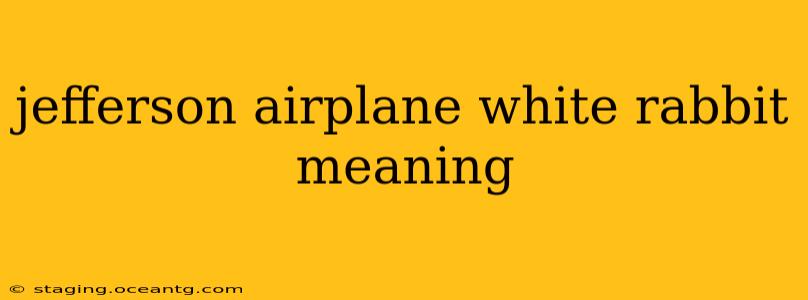Grace Slick's haunting vocals and the psychedelic soundscapes of Jefferson Airplane's "White Rabbit" have captivated listeners for decades. But what exactly is the song about? The beauty of "White Rabbit" lies in its ambiguity, allowing for multiple interpretations, all stemming from the potent symbolism of Alice in Wonderland. Let's unravel some of the most prevalent meanings and explore some frequently asked questions.
What is the main theme of "White Rabbit"?
The primary theme of "White Rabbit" centers around the dangers and allure of drug use, specifically hallucinogens, but it also extends beyond mere substance abuse. The song acts as an allegory for the exploration of altered states of consciousness, be it through drugs, spirituality, or even the intense experiences of adolescence and self-discovery. The Wonderland imagery provides a framework for navigating the unsettling, unpredictable, and sometimes terrifying aspects of this journey. The "white rabbit" itself is a guide, a tempting symbol leading down a path that promises adventure but holds unknown risks.
What does the "white rabbit" symbolize in "White Rabbit"?
The white rabbit, directly borrowed from Lewis Carroll's Alice's Adventures in Wonderland, acts as a powerful symbol of temptation and the unknown. It represents the alluring but potentially dangerous path into altered states of consciousness. Following the rabbit leads Alice – and the listener – down a rabbit hole into a world of surreal experiences, mirroring the effects of psychedelic drugs or the exploration of the subconscious mind. It's an invitation, a siren call that promises wonder but also holds the potential for chaos and disorientation.
Is "White Rabbit" about LSD?
While Grace Slick has never explicitly confirmed the song is solely about LSD, its lyrical content strongly suggests a connection to psychedelic drug experiences. The references to "one pill makes you larger, and one pill makes you small," and the overall surreal and disorienting imagery strongly align with the effects of hallucinogens like LSD. However, the song's power lies in its ability to resonate with anyone who has experienced a significant shift in perspective or a journey into the unknown, making its message far more universal than simply about one specific drug.
What are the other interpretations of "White Rabbit"?
Beyond its connection to drug culture, "White Rabbit" lends itself to multiple interpretations:
-
Political and Social Commentary: Some argue the song's psychedelic journey reflects the tumultuous social and political climate of the 1960s, a time of intense upheaval and questioning of established norms. The "rabbit hole" could symbolize a descent into the complexities and uncertainties of a changing world.
-
Spiritual Awakening: The song's exploration of altered states of consciousness can be viewed as a metaphor for a spiritual awakening or a journey of self-discovery. The "wonderland" becomes a representation of the inner world, and the "white rabbit" guides the listener towards an expanded awareness.
-
Coming-of-Age Story: The experience depicted in "White Rabbit" could also be interpreted as the confusing and sometimes disorienting journey of adolescence and the transition into adulthood. The song captures the feeling of being lost, searching for meaning, and confronting the unknown.
How does Alice in Wonderland relate to "White Rabbit"?
The allusions to Alice's Adventures in Wonderland are central to the song's meaning. Carroll's tale serves as a framework for exploring themes of illusion, reality, and the unpredictable nature of life. The song borrows imagery and characters from the story to create a powerful allegory for the experiences it depicts, whether it's the effects of drugs, a journey of self-discovery, or a commentary on the wider social landscape.
"White Rabbit" remains a timeless masterpiece, its evocative lyrics and haunting melody continuing to resonate with listeners across generations. Its enduring appeal lies in its ability to transcend simple interpretations, allowing individuals to connect with its themes on a deeply personal level. The song's ambiguity, rather than being a flaw, is its strength, inviting countless interpretations and sparking ongoing discussions about its true meaning.
